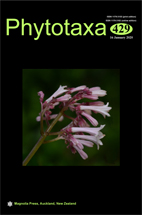Abstract
The fern family Gleicheniaceae was established by Presl (1825: 10) from the order Gleicheneae created by Brown (1810: 160) to accommodate two genera: Platyzoma Brown (1810: 160) and Gleichenia Smith (1793: 419). When the genus Gleichenia was established by Smith (1793), it included only G. polypodioides, but the genus concept was later used in a broader sense to include all Gleicheniaceae species known until the early 20th century (Diels 1900, Christensen 1905). The name proposed by Smith (1793) is a later homonym conserved against Gleichenia Necker (1790: 314) (Dryopteridaceae) (Nomenclature Committees 1954), and Gleichenia Smith is currently used with a narrow circumscription, with about 10 species (PPG I 2016). Nowadays, Gleicheniaceae is divided into six genera, although their monophyly is still questionable (PPG I 2016). The nomenclature of the family still needs attention due to the existence of few papers dealing with this subject as noted by Lima et al. (2018) and Lima & Salino (2018). While conducting taxonomic studies in Gleicheniaceae, we realized that the Linnaean name Onoclea polypodioides Linnaeus (1771: 306), the type species of Gleichenia, was not properly typified, as we explain in the next paragraphs.

